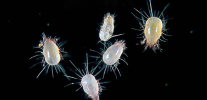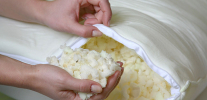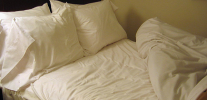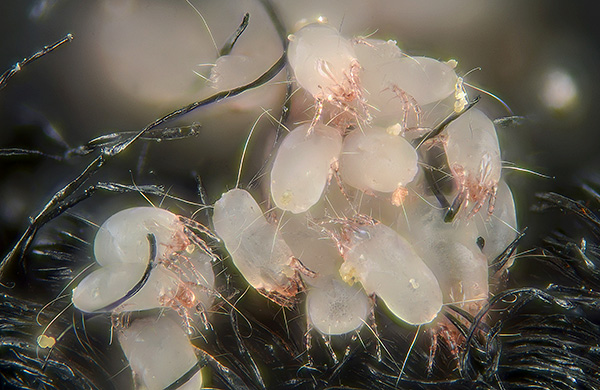
According to statistics, about 30-50% of city apartments are inhabited by dust mites, which are the cause of many cases of allergies. Studies have shown that respiratory diseases of unclear etiology (including asthma) are also often caused by household dust, which often contains waste products of insects and arachnids, which are strong allergens for many people.
It may seem surprising, but even in a seemingly clean room hundreds of thousands of dust mites can live. They are very small (not visible to the naked eye), do not bite a person and do not pay attention to themselves. At the same time, people in the room may suffer from persistent runny nose, conjunctivitis, dermatitis, allergies for years, and they cannot find the cause of the diseases. While the danger is sometimes hidden very close - literally under the pillow ...
General view: who are dust mites?
Dust mites are small arthropods of the order of acariform mites that live in private houses and apartments and feed on mostly peeling dry skin and human hair.
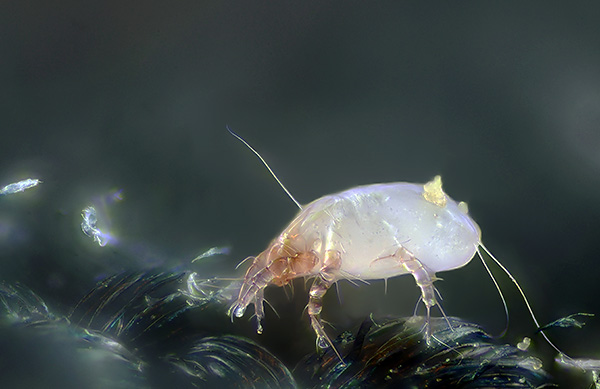
These creatures do not bite a person, do not suck his blood and do not even bite the skin directly on the body. All their livelihoods are endless swarming in ordinary household dust, in which they find flakes of dry, exfoliated epidermis and eat them.
On a note
For many people, the idea of having such ticks in the house may seem fantastic. Of the total supra-order ticks, Ixodes are the most well-known — rather large and found only in the wild (the very ones that are carriers of tick-borne encephalitis and borreliosis). It can be difficult to imagine that among their relatives there are those who are not distinguishable without a microscope and can live in an apartment all the time (moreover, in pillows and mattresses). However, this is true.
Dust mites have 8 paws, developmental characteristic of all mites and the structure of the body typical of the whole supernumerary. And their tiny size is not at all something out of the ordinary.The overwhelming majority of ticks are microscopic forms, ranging from iron plants that inhabit the skin of almost all adults on Earth, and ending with scabies itching, causing scabies.
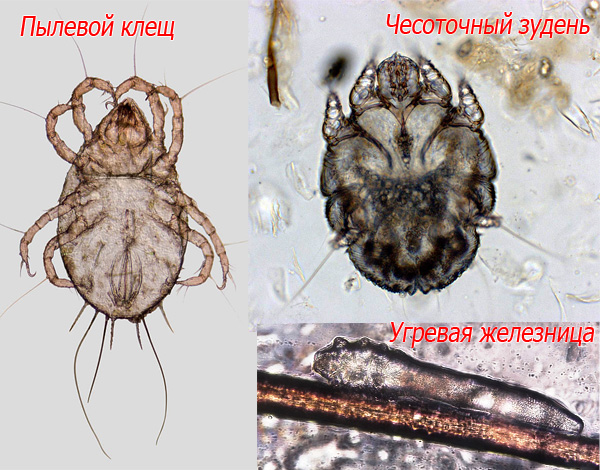
On a note
Due to their tiny size, mites were able to occupy almost all ecological niches on the planet - they process rotting organic matter in the soil, harm plants, parasitize on a huge number of animals (including insects), survive even in conditions in which other creatures cannot live permanently. . For example, ticks are known that live permanently in the crevices of rocks on the arctic islands and feed on only a few weeks a year on birds that make nests here (the rest of the time these creatures are starving). Equally well known, for example, is a wine mite settling on film in barrels of wine and feeding on a floating mist in such containers. Some mites can even live and breed within the human gastrointestinal tract, causing serious illness.
Dust mites have occupied a clearly defined niche - they live near the places of rest and permanent human habitat and feed primarily on parts of its dead skin.In this regard, they have developed specific features of morphology, physiology and biology, which allowed them to adapt to such a way of life as effectively as possible.
And they could become quite good nurses in a person’s housing, recycling household dust, if they didn’t have a few harmful and dangerous features, which we’ll talk about below.
What they look like: the appearance of larvae, adults and eggs
Adult dust mites have a solid, translucent, oval-shaped body with eight limbs. The larvae look the same, only they lack one pair of legs - this pair develops after the first molt.
After molting, the larva turns into a nymph - it looks similar to adult mites, leads a similar way of life, but has a smaller size and, most importantly, is not capable of reproduction. After several molting, the nymph becomes a mature individual (imago).
An adult dust mite is shown in the photograph taken with a scanning electron microscope:
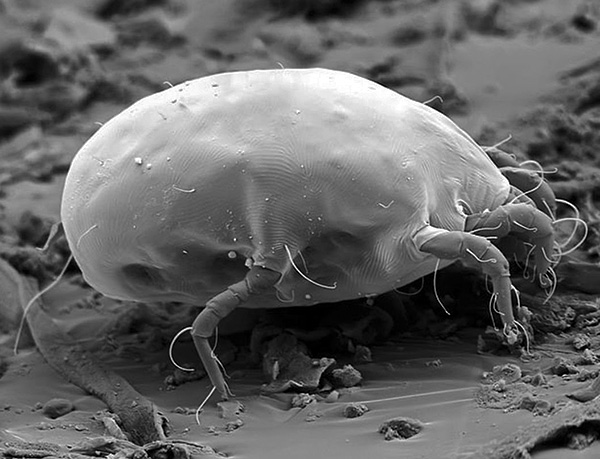
The size of adult ticks ranges from 0.3 to 0.5 mm, and, taking into account the translucent body, they are practically indistinguishable with the naked eye.
The photo shows the accumulation of dust mites in the carpet (this is their favorite habitat, which is why they are often also called carpet mites):
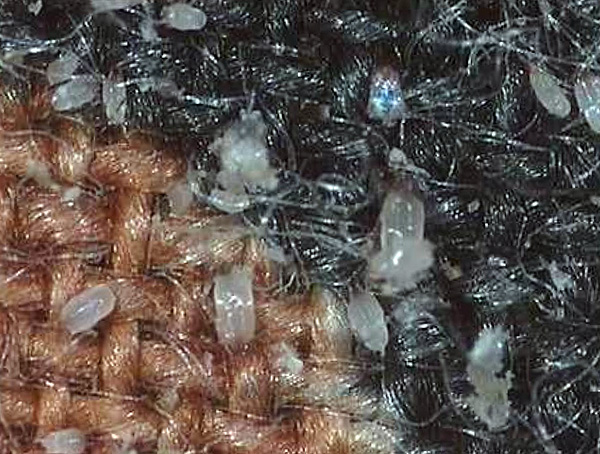
It is interesting
The whole body of dust mites is covered with special hairs and bristles, which perceive the vibrations of the air and help orient themselves in space. Given that they have no eye, it is these organs of touch and very good sense of smell that allow them to find food and partners for reproduction.
For fixing on the substrate, the limbs of dust mites are equipped with suction cups - this allows them to move on virtually any surface. They also have special fatty glands, thanks to the secretions from which their body is not moistened with water.
The eggs of dust mites are rather large, reaching a diameter of up to half the size of the female body. They have a whitish color and are located in groups - ovipositories.

Micrograph shows such an egg at high magnification:
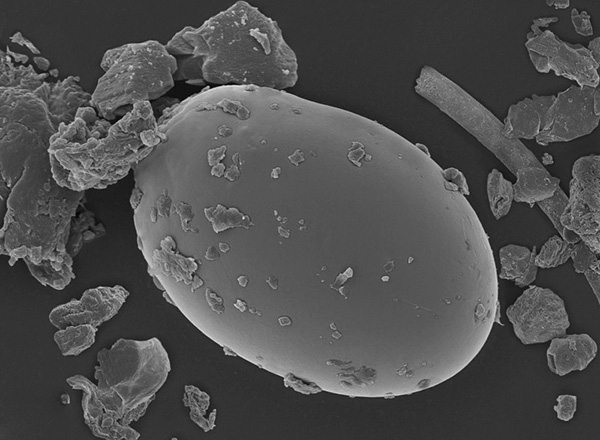
The larva emerging from the egg is very small - up to 0.2 mm. You can see it only under a microscope.
Both larvae and adult dust mites have a well-developed gnawing mouth apparatus, for which they are often called chewing.In this case, they do not have such a stretchable cuticle, which is present in blood-sicking ixodic ticks, since they do not need a one-time saturation with huge amounts of food. They eat regularly and in small portions.
Nutrition specifics
The basis of the dust mite diet is exfoliated epidermis of humans and domestic animals, accumulating in house dust, on the bed, in pillows, on mattresses, behind baseboards. Every person loses about 1.5 g of dry skin during the day - this is enough to feed several thousand ticks.
Also, studies have shown that dust mites actively eat mold fungi, and more than 16 types of mold have been found in their diet. However, mold is a minor feed object to which these arthropods pass only when there is a shortage of the main feed.

On a note
It is a misconception that allergies are caused by dust mite bites. In fact, they do not bite humans and animals and do not suck blood. Unlike ixodid ticks, they are not parasites, and feed mainly on dead skin particles. Also, they are not carriers of diseases and do not infect either humans or domestic animals with any infections. In addition, they do not spoil the food.
As a result, the main accumulations of dust mites in residential areas are found where people and domestic animals spend the most time and where the peeling epidermis scales accumulate in the greatest amounts. Basically, these arthropods are concentrated in mattresses, pillows, in the dust under the beds and behind baseboards, in pet resting places. At the same time, they are inactive, and practically do not move within the premises - having been born, for example, in a pillow, the tick, most likely, will live its whole life in it.
Danger to humans
Dust mites can cause all three types of allergic reactions in a person - respiratory, contact and food. Due to the nature of their diet, they are very close to a person throughout his life, and therefore the allergens secreted by them are likely to fall into the human body sooner or later.
For a person, tick excrements that are no larger than 10 microns are dangerous. They contain proteins called Der f1 and Der p1 - digestive enzymes that help break down dead skin cells so that they can be digested.When injected into the human body, excreta of dust mites very often cause a sensitization reaction, and because of their small size, they often penetrate into the airways with dust in the air.
The photo below shows the mites in the carpet, with small grains of excrement visible on each individual and on the fabric around them:
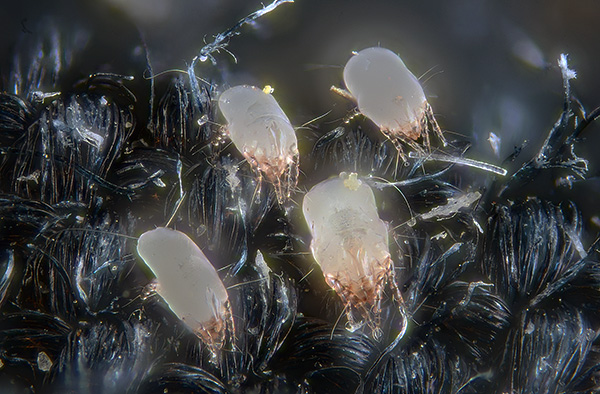
As a result, these pests bring the greatest harm to people suffering from respiratory diseases. Up to 80% of patients with bronchial asthma are susceptible to tick-borne allergies (in many of them asthma itself is the cause of persistent rhinitis amid allergy to ticks). At the same time, the number of such patients may include people from different age groups: both children, starting from infancy, and old people. Many cases of chronic rhinitis and nasal congestion without a cold are just the consequences of such an allergy.
On a note
It is known that in more than 50% of cases tick-borne sensitization develops in a child in infancy.
In this case, the weight of the feces excreted by each individual during life is approximately 200 times the weight of its own body. Thus, the total number of allergens excreted by the entire population of ticks in an apartment can be huge.
When cleaning a person or just moving a person around an apartment, dust often rises into the air and does not sink for tens of minutes. A person can easily inhale it, after which foreign proteins act on the respiratory organs and cause allergies.
On a note
In the course of the research, scientists found out that the development of tick sensitization makes a person more sensitive to other allergens, such as feline and canine. Frequent skin contact with tick excrement can lead to impaired barrier function of the integument. So there is another channel for the entry of foreign biological substances into the body.
It is also worth noting that not only the owners of the premises, but also pets can suffer from tick-borne allergies.
Dead mites and skins of larvae after molting are also dangerous. Chitin shells irritate the airways when inhaled and also cause allergies.
People with allergies to dust mites may exhibit the characteristic symptoms of allergic rhinitis:
- Persistent itching on the skin, in the nose;
- Rash over the whole body (but more often on the face);
- Cough, sneezing, nasal congestion, runny nose;
- Redness and tearing of the eyes;
- Shortness of breath and difficulty breathing.

In some cases, drowsiness, fatigue, frequent headaches, impaired concentration and reduced performance.
In more severe cases, tick-borne allergy leads to bronchial asthma, atopic dermatitis, acarodermatitis, chronic rhinitis, conjunctivitis, respiratory allergies, angioedema.
In patients with bronchial asthma, the condition worsens immediately after bedding, where the concentration of ticks is usually greatest.
To diagnose tick-borne allergy, an examination by an immunologist is necessary. You will need a blood test for the presence of immunoglobulins - antibodies to dust mite proteins, and skin tests will be carried out.
For carrying out skin tests, prick tests and patch tests are used. In the first case, a liquid antigen is applied to the scratched surface of the back or forearm, and after 15 minutes, the local reaction is examined. In the second embodiment, the integrity of the skin does not violate, but simply stick the patch and evaluate the changes over a long time (48, 72 and 96 hours after the start of the study).
The patch test is used to determine the cause of chronic diseases, such as contact dermatitis.
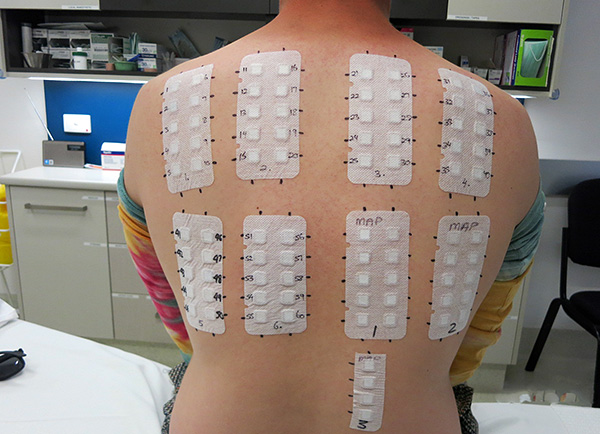
In intranasal tests, the allergen is introduced by inhalation, and the reaction of the nasal mucosa is observed. Conjunctivitis, bronchial test, spirometry and rhinomanometry tests are used.
With the help of special molecular diagnostics, it is possible to identify which protein is the reaction to. Currently, scientists have identified twenty-four allergens that may be present in dust mites. This is important for the effective treatment of the patient and the selection of the right way of desensitization.
Allergy symptoms are reduced with the help of medications prescribed by a doctor.
On a note
Also an effective treatment is ASIT - allergen-specific immunotherapy. When it is injected into the human body with certain intervals in time, an allergen extract (for example, the drug staloreal) is introduced with a constantly increasing concentration. It is believed that in this case tolerance of the immune system to the allergen develops, although the exact mechanism of action of such agents is not yet fully understood.It is only known that there is a change in the immune response of T-lymphocytes - special cells of the body, which play an important role in the development of acquired immunity.
In any case, the treatment of advanced allergy to dust mites is much more difficult than the prevention of mass reproduction of these pests in the room.
Habitat and lifestyle of dust mites
The favorite microbiotopes of dust mites in a person’s dwelling are bedding, wall and floor carpets, floor corners, bookshelves, and wardrobes.

Up to half of the apartments in the cities are to some extent inhabited by dust mites, which are known for about 13 different species. They are spread all over the world, and live in almost any premises, regardless of their area and quality of repair. Only species diversity in different regions and population sizes differ. For example, the species Dermatophagoides siboney is distributed only in Cuba - in other countries it has not yet been found.
The European dust mite Dermatophagoides pteronyssinus and the American dust mite Dermatophagoides farinae are the most common in the world.
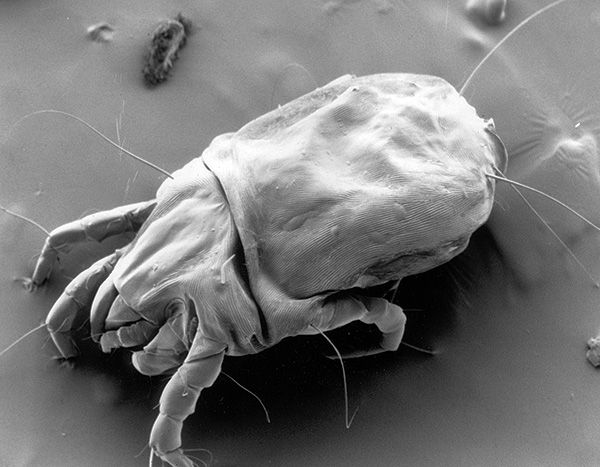
In countries with a subtropical climate, the number of ticks in the rooms is greatest,and in mountainous areas, the number of individuals in populations decreases with elevation. In hot and dry climates, these pests are less common.
Each area has its own characteristics of the speed of reproduction of ticks and an increase in the number of populations. For example, in the middle zone it is most active in the fall and spring, and in the coastal areas - in the spring and summer. During this period it is necessary to carry out measures to destroy ticks and their excretions.
It is interesting
Debating remains the question of where the dust mites appear in the house. Given their inactivity, it is difficult to argue that they penetrate the room themselves. They were supposed to enter housing with bird feathers in pillows from various industries where mites can feed on feather scales in the dust. However, there are controversial points here: pillows with a synthetic filler are also infected with dust mites, although to a lesser extent.
Most likely, the resettlement occurs with any things already infected.
No dust mites population was found outside the dwelling of people. That is, they are typical synanthropic organisms.
The most favorable conditions for the life of dust mites are darkness and high humidity with a temperature of about 25 ° C. Thus, in rooms with an average relative humidity of less than 50%, mites are detected in 30% of cases, and with humidity over 70% - in 100% of cases.
It is interesting
During the study of the migration of dust mites to wetter environments, an interesting pattern emerged. When setting the experiment, scientists “suggested” two paths to moisture to the arachnids, which are no different from each other. And after some time, it was found that most individuals move only along one path for no apparent reason. From this it was concluded that there are some special substances that emit ticks, "showing" the road next. The nature of these substances has not yet been elucidated, but perhaps in the future it will help the development of new, more successful methods of dealing with ticks.
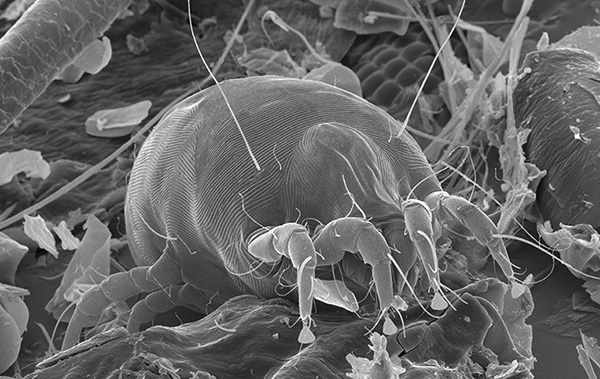
One of the most preferred microbiotopes of dust mites is upholstered furniture, especially a sleeping place. There, the person creates ideal conditions for them, heating the bed during sleep to the optimum temperature with his body (about 8 degrees higher and 7% wetter than the average room). And then supplies the destroyers of their own health with food - with particles of their skin.
Ticks settle in household dust in groups of 10 to 10,000 individuals per gram of dust. A safe concentration for a healthy person is no more than 100 ticks per gram. It is at high concentrations (up to 500 individuals per 1 gram) that the development of bronchial asthma and other complications most often occurs.
Interestingly, in each of the bedding, its own, to some extent unique, ecological conditions are created, due to which the size of the colonies and the species diversity of the ticks living here may differ.
For example, a regular mattress can contain from 100 thousand to 10 million individuals - approximately up to 140 specimens per gram. The frequency of occurrence of pests here is greatest, and it decreases with distance from the source of infection. The lowest concentration is on the floor (on average, about 18 individuals per 1 gram of dust).
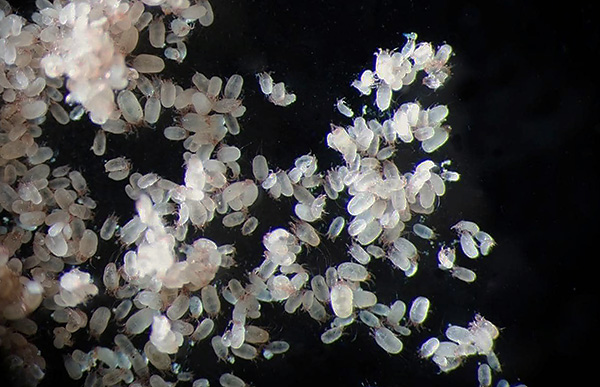
Ticks also live in pillows, rugs, carpets, soft toys, paper books, slippers, clothes, car seats. After all, it is here that the largest amount of dust accumulates. And, of course, in a vacuum cleaner, where optimal conditions are created for the reproduction of ticks: a dark enclosed space with poor ventilation and excess feed.
Reproduction and life cycle
Due to the small size and a small change in mass as it develops, dust mites do not need a lot of resources to grow - partly because of this they have a very high reproduction rate. As a result, in a short time their population in an apartment can reach an enormous number.
Ontogenesis - the cycle of individual development - runs from egg to egg in about 15-19 days. During this time, each individual goes through the following stages of development:
- Egg;
- Larva;
- Nymph;
- Mature individual.
During its not very long life (up to 80 days), the female has time to lay about 60 eggs - one at a time (because of its relatively large size, an egg can fit only in one body). Just a few days after laying the larvae hatch from the egg.
The release of the larvae from the egg occurs quite early, when the body has not yet formed the last pair of legs. The main function of the larva is feeding and settling, therefore from the first days of life it actively moves in search of food. After several feedings, she turns into a nymph. A nymph needs to be molded three times to grow to the size of an adult and form a reproductive apparatus, after which it turns into an imago and starts reproduction.
On a note
Dust mites have a complex external sexual apparatus. Interestingly, they have special organs - sexual suckers, which play an important role in egg laying. It is assumed that they perceive the humidity of the environment, which helps to find ideal conditions for future offspring.

Fertilization is spermatophoric: the male spermatozoa are in a special capsule protecting them from external influences. The female captures these capsules with the help of the external genital organs - after that, until the end of her life, she will lay approximately one egg per day.
How to understand that dust mites live in the house?
Due to the small size of these tiny arthropods, it is impossible to detect with the naked eye. Therefore, their presence in an apartment is usually determined only at the stage of the onset of allergic symptoms in a person - these can be breathing problems, cough, runny nose, rash and itching, tearing and redness of the eyes, regular headache, fatigue.
More accurate methods are associated with the use of special equipment:
- Counting with a microscope in which adults, nymphs and eggs are visible.In this case, dust and substrates are studied from the places of the most frequent accumulation of mites - mattresses, pillows, carpets;
- Determination of the content of guanine in the dust (guanine is present in the arachnid excrement) - this analysis allows us to conclude about the presence or absence of these creatures in the apartment;
- Immunochemical analysis of allergens, clearly indicating that the dust contains digestive proteins of ticks.
Specially developed chemical test systems will help you to find out dust mites at home. Each of them consists of 10 tests, which allows to analyze dust from different parts of the apartment in order to find the epicenter of the infection. The kit includes a chemical reagent, a test strip, a dust collector and a color scale by which you can determine the concentration of ticks.

A dust sample is poured with liquid from the kit, then a test strip is placed in the formed mixture. A qualitative reaction is carried out, and the color is compared with a reference scale. However, the test is not accurate enough - it only shows how many or few ticks live in the room.
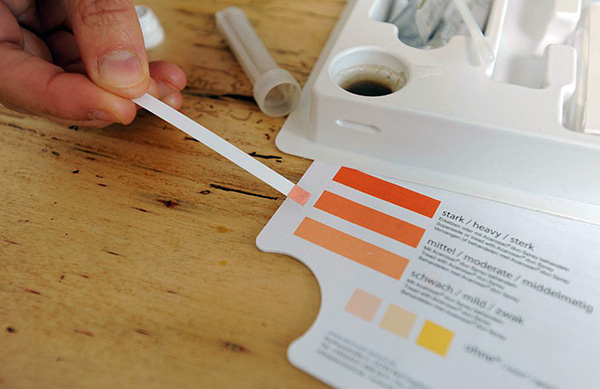
When working with a test system is important safety.The study should be carried out in a mask and rubber gloves. If the reagent comes in contact with the skin, rinse immediately with plenty of water.
The price of such a test system is in the range of 3,500 rubles; therefore, it is more rational to use each of the 10 tests to periodically check during the period of fighting dust mites.
Ways of destruction
There are many methods to get rid of dust mites in the apartment - they can be divided into chemical and physical methods of exposure.
Chemical methods include the use of various acaricides and insecticides. Among them are both common drugs (Karbofos, Dichlorvos Neo, Reid against flying and crawling insects, etc.), and more focused drugs (Teflobenzuron, Clofentezin, Parargit and others).
Most insecticidal sprays and commercially available aerosols will be more or less effective against dust mites. However, they can also be toxic for humans, and the treatment of the apartment is rather laborious for them. When using them, first of all, it is necessary to disinfect upholstered furniture and carpets, as well as to deacterize plastic slippers and shoes with a fleecy lining in plastic bags.In general, processing is carried out in much the same way as in the destruction of bugs or cockroaches (the only difference being that the focus is not on finding the nests of insects, but on areas of dust accumulation).

On a note
Attempts to use traditional anti-dust mites, such as caraway, wormwood, clove, lavender, or tea tree oil (added to detergents), are popular. It is assumed that ticks are afraid of the smell of essential oils, but in reality the effectiveness of this method is low. Even if one or another folk remedy is capable of scaring off ticks, they will not disappear from the apartment, since they are physically unable to move a long distance. Kill them with micro-quantities of essential oils that are added to the water when washing floors, will not work.
The physical methods for the destruction of dust mites include the action of high and low temperatures.
The experiments showed that the action of direct sunlight for 3 hours, as well as temperatures above + 60 ° C or less than -20 ° C for at least 30 minutes, leads to the death of eggs, larvae, nymphs and imago dust mites. At a temperature of + 6 ° C, egg development does not occur, but their viability can last up to 6 weeks.
Due to this, it is possible to destroy dust mites by washing at high temperatures bedding, curtains, bedspreads and soft toys, as well as ironing things with an iron or by steam cleaning. It should be borne in mind that at temperatures below 40 ° C up to 93% of individuals remain intact.

Things that can not be washed can be subjected to freezing - ticks do not tolerate cold (below -20 ° C). No less effective is the "burning" in the sun - ticks die under the action of heat and ultraviolet rays. Quartzization of the room is partly effective (both due to the action of UV radiation and due to the action of ozone).
Ticks are most sensitive to air humidity - with a long decline below 40% (for several days), the entire population may die.
It also helps regular floor cleaning and dusting - it allows you to destroy most of the arthropods by simply mechanically removing them along with the dust.
The most effective is the use of all the above methods in the complex, and not separately. This dramatically increases the productivity of events and helps in a short time to get rid of dust mites in the house.
Prevention of tick infestation
The main place in the prevention of contamination of an apartment with mites is reduced by the amount of dust in the room and, accordingly, its accumulation sites. This is the rejection of wool carpets in favor of vinyl coatings, the replacement of heavy curtains and tapestries, the storage of books and magazines in glazed cabinets (dust mites can accumulate in all the places listed).

Especially needed:
- Frequent airing of the room;
- Regular wet cleaning;
- Regular cleaning of the vacuum cleaner, air conditioners and air purifiers;
- Periodic washing of bed linen at a temperature of at least 60 ° C.
Ticks settle in all types of fabrics; however, as part of preventive measures, it is preferable to use synthetic fabrics, as they dust less and tolerate washing at high temperatures better. You can use polyurethane mattresses and pillows with synthetic padding, polystyrene covers for upholstered furniture, eurocovers and mattress covers.
On a note
Studies have shown that dense synthetic materials in 99% of cases block the settlement and movement of ticks.In the most effective coatings, the pore size does not exceed 10 microns.
Do not forget that dust mites are very sensitive to changes in humidity - this is one of the key factors influencing them. Therefore, maintaining a dry microclimate in the room will significantly reduce the risks of the development of a pest population here, and if an apartment is already infected, it will help remove them.
Interesting video: so dust mites look under a microscope
About dust mites and house dust allergies

